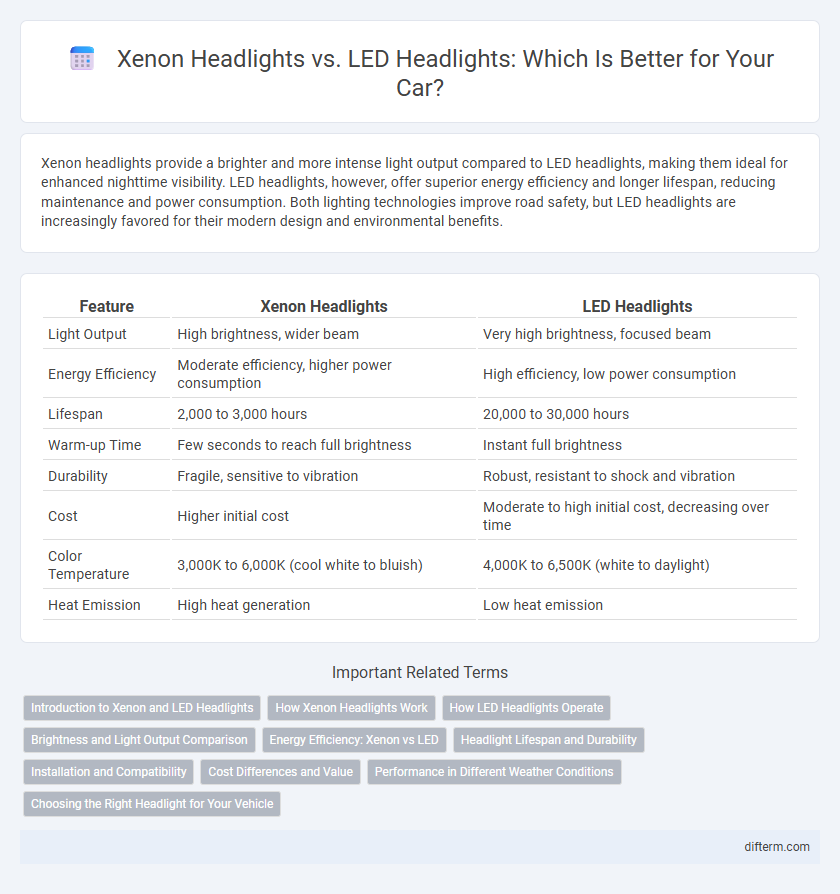Xenon headlights provide a brighter and more intense light output compared to LED headlights, making them ideal for enhanced nighttime visibility. LED headlights, however, offer superior energy efficiency and longer lifespan, reducing maintenance and power consumption. Both lighting technologies improve road safety, but LED headlights are increasingly favored for their modern design and environmental benefits.
Table of Comparison
| Feature | Xenon Headlights | LED Headlights |
|---|---|---|
| Light Output | High brightness, wider beam | Very high brightness, focused beam |
| Energy Efficiency | Moderate efficiency, higher power consumption | High efficiency, low power consumption |
| Lifespan | 2,000 to 3,000 hours | 20,000 to 30,000 hours |
| Warm-up Time | Few seconds to reach full brightness | Instant full brightness |
| Durability | Fragile, sensitive to vibration | Robust, resistant to shock and vibration |
| Cost | Higher initial cost | Moderate to high initial cost, decreasing over time |
| Color Temperature | 3,000K to 6,000K (cool white to bluish) | 4,000K to 6,500K (white to daylight) |
| Heat Emission | High heat generation | Low heat emission |
Introduction to Xenon and LED Headlights
Xenon headlights use high-intensity discharge (HID) technology, producing a bright white-blue light that enhances nighttime visibility and vehicle safety. LED headlights rely on light-emitting diodes to generate a focused, energy-efficient beam with longer lifespan and quicker illumination response compared to traditional bulbs. Both lighting technologies offer distinct advantages in brightness, durability, and power consumption for modern automotive applications.
How Xenon Headlights Work
Xenon headlights operate by producing light through an electric arc between two tungsten electrodes within a xenon gas-filled bulb, resulting in a bright, white-blue illumination. The gas ionizes when the current passes through, creating intense, high-temperature light that enhances nighttime visibility for drivers. Compared to LED headlights, xenon lights offer a more focused beam with greater penetration in foggy or rainy conditions, improving road safety.
How LED Headlights Operate
LED headlights operate by passing an electric current through semiconductor materials, causing them to emit light through electroluminescence. Unlike xenon headlights that use gas discharge to produce light, LEDs generate illumination instantly and with greater energy efficiency. Their compact design allows for more flexible headlamp shapes and improved durability in automotive applications.
Brightness and Light Output Comparison
Xenon headlights produce a higher brightness intensity, typically ranging between 3,000 to 3,500 lumens, offering superior illumination for long-distance visibility on dark roads. LED headlights provide a more consistent light output of around 2,000 to 4,000 lumens, with enhanced energy efficiency and quicker startup times. While xenon lights excel in brightness, LED technology offers a broader, more evenly distributed beam pattern that improves overall road visibility.
Energy Efficiency: Xenon vs LED
LED headlights consume significantly less energy compared to xenon headlights, offering around 85% better energy efficiency while maintaining equivalent or superior brightness. Xenon headlights require higher wattage to operate, typically around 35 watts, whereas LED systems use approximately 15-20 watts, reducing power consumption and enhancing overall vehicle fuel efficiency. This energy efficiency in LED headlights also contributes to longer battery life and lower emissions in electric and hybrid vehicles.
Headlight Lifespan and Durability
Xenon headlights typically offer a lifespan of around 2,000 to 3,000 hours, making them less durable compared to LED headlights, which often last between 25,000 to 30,000 hours. LED headlights provide greater resistance to vibrations and shocks due to their solid-state design, enhancing durability in off-road and rough driving conditions. The extended lifespan and robust construction of LED technology contribute to reduced replacement frequency and lower long-term maintenance costs for automotive lighting systems.
Installation and Compatibility
Xenon headlights require a ballast for installation, making the process more complex compared to LED headlights, which often feature plug-and-play designs compatible with most vehicle wiring systems. LED headlights offer greater compatibility with modern automotive electrical systems and can fit into a wider range of headlight housings without significant modifications. Vehicle models with integrated advanced driver-assistance systems may demand specific LED units to maintain full compatibility and sensor functionality.
Cost Differences and Value
Xenon headlights typically have a higher upfront cost due to complex ballasts and bulbs, whereas LED headlights, despite a higher initial price, offer longer lifespan and lower energy consumption, reducing maintenance and operational expenses. The value of LED headlights is enhanced by superior durability and efficiency, contributing to overall cost savings over time compared to xenon systems. Evaluating total ownership costs, LED headlights provide better return on investment through extended use and energy efficiency.
Performance in Different Weather Conditions
Xenon headlights provide intense, bright light that penetrates fog and rain effectively, enhancing visibility in adverse weather conditions. LED headlights offer quicker illumination and better color temperature, improving contrast and reducing glare for safer driving in snow or mist. Both technologies outperform traditional halogen bulbs, but LEDs excel in energy efficiency and adaptability to different weather environments.
Choosing the Right Headlight for Your Vehicle
Xenon headlights deliver intense, bright light with a color temperature close to natural daylight, making them ideal for long-distance visibility on highways. LED headlights offer superior energy efficiency, longer lifespan, and faster illumination response, which enhance safety and reduce maintenance costs. Selecting the right headlight depends on factors like driving conditions, vehicle compatibility, and budget considerations, with LED technology increasingly preferred for modern vehicles due to its advanced performance and durability.
xenon headlights vs LED headlights Infographic

 difterm.com
difterm.com